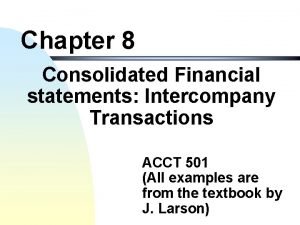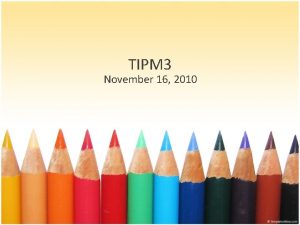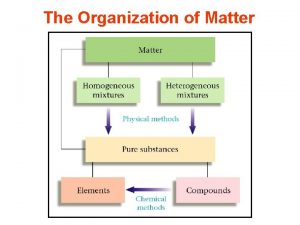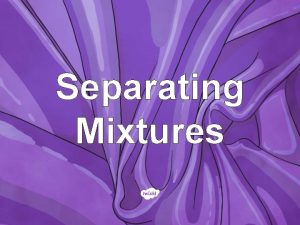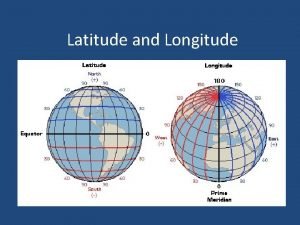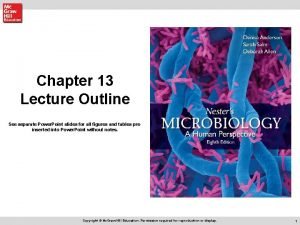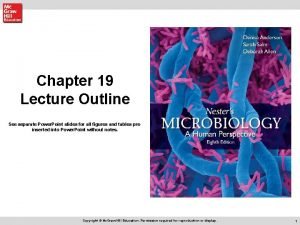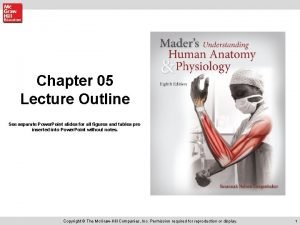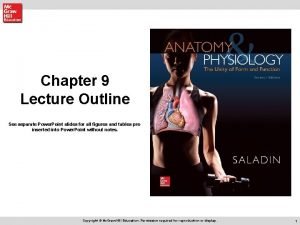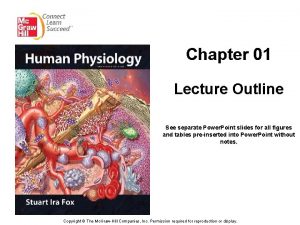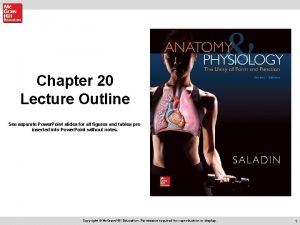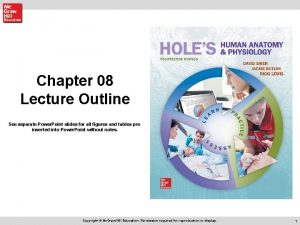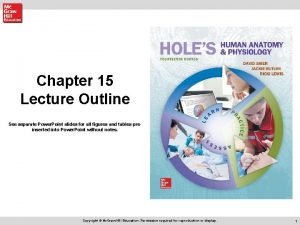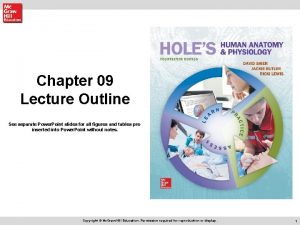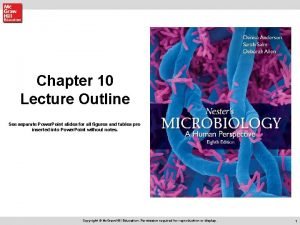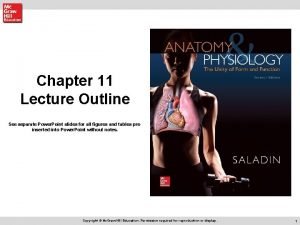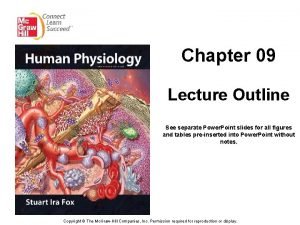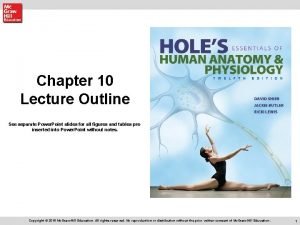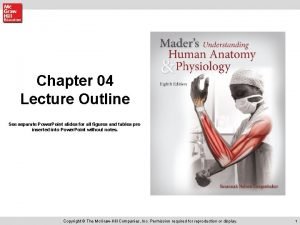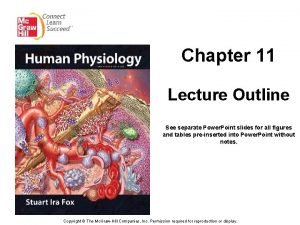Chapter 05 Lecture Outline See separate Power Point































- Slides: 31

Chapter 05 Lecture Outline See separate Power. Point slides for all figures and tables preinserted into Power. Point without notes. Copyright © Mc. Graw-Hill Education. Permission required for reproduction or display. 1

5. 1: Cells are Organized into Tissues • In complex organisms, cells are organized into tissues • Tissues: Groups of similar cells with a common function • The study of tissues is called histology. • There are 4 major types of tissues in the body: 1. Epithelial tissue 2. Connective tissue 3. Muscle tissue 4. Nervous tissue 2

Intercellular Junctions • Tight junctions: • Membranes between cells merge and fuse • Located among cells that form linings, sheetlike layers • Blood-brain barrier • Desmosomes: • Form “spot welds” between cells • Structural reinforcement • Located among outer skin cells • Gap junctions: • Tubular channels between cells • Molecules can move between cells • Located in cardiac muscle cells 3

5. 2: Epithelial Tissue General Characteristics: • Covers organs and body surface • Lines cavities and hollow organs • Makes up glands • Have a free surface on outside, and basement membrane on inside • Usually lack blood vessels; nutrients diffuse from underlying connective tissue • Cells readily divide; injuries heal rapidly • Cells are tightly packed • Classified according to cell shape and number of cell layers • Shapes: squamous (flat), cuboidal (cube-shaped), columnar (tall) • Layers: simple (one layer of cells), stratified (2 or more layer of cells), or pseudostratified (appears layered, but is not) 4

Epithelial Tissue Types Simple squamous: • • • Single layer of thin, flat cells Substances pass easily through Thin & delicate, can be damaged Found in diffusion & filtration sites Lines air sacs (alveoli) & capillaries Lines blood & lymphatic vessels Simple cuboidal: • Single layer of cube-shaped cells • Secretion and absorption • Lines kidney tubules, thyroid follicles • Covers ovaries • Lines ducts of some glands 5

Epithelial Tissue Types Simple columnar: • Single layer of elongated cells • Nuclei usually at same level, • • • near basement membrane Sometimes have cilia Sometimes have microvilli Sometimes have goblet cells (secrete mucus) Secretion and absorption Lines uterus, stomach, intestines Pseudostratified columnar: • Single layer, but appears layered • Nuclei at 2 or more levels • Cells vary in shape • Often has cilia, goblet cells • Protection from infection • Lines respiratory passageways 6

Epithelial Tissue Types Stratified squamous: • • • Many cell layers; thick Protective layer Outermost cells are flat Deeper cells are cuboidal New cells form, push older cells toward free surface • Outer layer of skin (keratinized) • Lines oral cavity, vagina, anal canal Stratified cuboidal: • 2 -3 layers of cube-shaped cells • More protection than 1 layer • Lines ducts of mammary, sweat, & salivary glands, and pancreas 7

Epithelial Tissue Types Stratified columnar: • Top layer of elongated cells • Cube-shaped cells in deeper layers • Lines part of male urethra, ducts of exocrine glands Transitional (uroepithelium): • Many cell layers • Cube-shaped and elongated cells • Changes shape with increased tension; stretches • Line urinary bladder, ureters, and part of urethra 8

Glandular Epithelium • Glandular Epithelium: Composed of cells that produce and secrete substances into ducts or body fluids • There are 2 types of glands: • Endocrine glands secrete into tissue fluid or blood • Exocrine glands secrete into ducts that open onto surface 2 structural types of exocrine glands: • Unicellular: Composed of one cell, such as a goblet cell (secretes mucus) • Multicellular: • Composed of many cells • Sweat glands, salivary glands, etc. • Simple or compound 9

Structural Types of Exocrine Glands Simple: duct does not branch Compound: duct branches before it reaches secretory portion Tubular: consist of epithelial-lined tubes Alveolar: terminal portions form saclike dilations 10

Types of Glandular Secretion Merocrine Glands: Secrete fluid products by exocytosis; salivary & sweat glands, pancreas Apocrine Glands: Lose small part of cell during secretion; mammary & ceruminous glands Holocrine Glands: Release entire cells filled with product; sebaceous glands 11

5. 3: Connective Tissues General characteristics: • Most abundant tissue type • Cells are farther apart than epithelial cells; contain matrix between cells • Many functions: • Bind structures together • Provide support and protection • Serve as frameworks • Fill spaces • Store fat • Produce blood cells • Protect against infections • Help repair tissue damage • Extracellular matrix consists of protein fibers and ground substance; consistency varies from fluid to semisolid to solid • Most have good blood supply, and are well-nourished, but vascularity varies among tissue types • Most cells can divide 12

Major Cell Types of Connective Tissue Fibroblasts: • Most common fixed cell • Large star-shaped cell • Secrete fibers into extracellular matrix Macrophages (Histiocytes): • Usually attached to fibers, but can detach and wander • Conduct phagocytosis • Defend against infection 13

Major Cell Types of Connective Tissue Mast Cells: • Large, fixed cells • Release heparin to prevent blood clotting • Release histamine, which causes inflammatory response 14

Connective Tissue Fibers Fibroblasts produce 3 types of fibers in connective tissue: Collagen Fibers: • Thick threads of collagen, the body’s main structural protein • Great tensile strength and flexible, slightly elastic • Found in ligaments and tendons Elastic (Yellow) Fibers: • • Composed of elastin protein; branching Can stretch and return to original shape Not as strong as collagen fibers Found in vocal cords, respiratory air passages Reticular Fibers: • Thin, branching fibers of collagen • Form delicate, supporting networks • Found in spleen, liver 15

Categories of Connective Tissue Connective tissues can be classified in 2 major categories: Connective Tissue Proper: • Loose connective tissues: - Areolar - Adipose - Reticular • Dense connective tissues: - Dense Regular - Dense Irregular - Elastic Specialized connective tissues: • Cartilage • Bone • Blood 16

Connective Tissue Types Areolar Connective Tissue: • • • Forms thin, delicate membranes Cells are mainly fibroblasts Gel-like ground substance Collagenous & elastic fibers In subcutaneous layer Beneath most epithelia, where it nourishes nearby epithelial cells Adipose Tissue: • • Adipocytes store fat Push their nuclei to one side Crowd out other cell types Cushions and insulates Beneath skin (subcutaneous layer) Behind eyeballs Around kidneys and heart Spaces between muscles 17

Connective Tissue Types Reticular Connective Tissue: • Composed of thin reticular fibers • Supports walls of internal organs • Walls of liver, spleen Dense Regular Connective Tissue: • • Closely packed collagenous fibers Fine network of elastic fibers Most cells are fibroblasts Very strong, withstands pulling Binds body parts together Tendons, ligaments, dermis Poor blood supply; slow to heal 18

Connective Tissue Types Dense Irregular Connective Tissue: • Randomly organized, thick, interwoven collagenous fibers • Can withstand tension exerted • from different directions • Dermis of skin • Around skeletal muscles Elastic Connective Tissue: • • Abundant yellow elastic fibers Some collagenous fibers Fibroblasts Attachments between bones of spinal column • Walls of hollow organs, such as large arteries, airways • Parts of heart • Elastic quality, stretches 19

Connective Tissue Types Cartilage: • • • A rigid, specialized connective tissue Support, framework, attachments Protection of underlying tissue Models for developing bone Matrix contains collagen in gel-like ground substance Chondrocytes (cartilage cells) in lacunae (chambers), surrounded by matrix • Lacks blood supply; heals slowly • Covered by perichondrium (connective tissue), which provides some nutrients to the cartilage • 3 types of cartilage: Hyaline, Elastic, and Fibrocartilage 20

Connective Tissue Types Hyaline cartilage: • • Most common type Fine collagen fibers Ends of bones in joints Nose, respiratory passages • Embryonic skeleton Elastic cartilage: • Flexible, due to elastic fibers in matrix • External ear, larynx 21

Connective Tissue Types Fibrocartilage: • Very tough, due to many collagenous fibers • • • Shock absorber Intervertebral discs Pads of knee and pelvic girdle 22

Connective Tissue Types • Bone (Osseous Tissue): • • • Most rigid connective tissue Solid matrix, composed of mineral (Ca) salts & collagen Supports structures Protects vital structures Produces blood cells Stores & releases Ca, P Attachment sites for muscles Forms skeleton Contain osteocytes (bone cells) in lacunae 2 types: compact and spongy 23

Connective Tissue Types Compact Bone: • • • Osteoblasts deposit matrix in lamellae (layers) Lamellae occur in rings around central canals Osteocytes + matrix + central canal form cylindrical units called osteons Osteons are cemented together to form compact bone Central canals contain blood vessels; bone is well-nourished, heals more quickly than cartilage 24

Connective Tissue Types Blood: • • • Cells suspended in fluid matrix called plasma Red blood cells transport gases White blood cells defend again infection Platelets help in blood clotting Transports substances around body 25

5. 4: Types of Membranes • Membranes are sheets of cells • Epithelial membranes are composed of epithelial and connective tissue; cover body surfaces and line cavities • 3 types of epithelial membranes: 1. Serous membranes: - Line body cavities that do not open to outside of body - Inner linings of thorax and abdomen; covers organs - Simple squamous epithelium + areolar connective tissue - Secrete serous fluid for lubrication, reducing friction 2. Mucous membranes: - Line cavities and tubes that open to the outside of body - Lining of digestive, respiratory, urinary, and reproductive tracts - Epithelium + areolar connective tissue - Goblet cells secrete mucus 26

Types of Membranes 3. Cutaneous membrane: - Covers body surface - Commonly called skin - Part of integumentary system Synovial membranes: - Different from epithelial membranes - Composed entirely of connective tissue - Line joint cavities 27

5. 5: Muscle Tissues General Characteristics: • Muscle cells are also called muscle fibers • Contractile; can shorten and thicken • 3 types of muscle tissue: skeletal, cardiac, and smooth Skeletal muscle tissue: • • • Attached to bones Striated Voluntary Multinucleated cells Long cylindrical cells Stimulated by nerve cells 28

Muscle Tissues Smooth muscle tissue: • • • Non-striated Spindle-shaped fibers Walls of hollow organs Walls of blood vessels Involuntary Cardiac muscle tissue: • • • Only in wall of heart Branching cells Involuntary Striated Intercalated discs 29

5. 6: Nervous Tissue Nervous tissues: • Found in brain, spinal cord, peripheral nerves • Main cells are neurons, which are specialized for communication, via conduction of nerve impulses (sensory reception, motor control) • Neurons coordinate, integrate, and regulate body functions • Neuroglia support and nourish neurons 30

Muscle and Nervous Tissues 31
 Essay writing c
Essay writing c 01:640:244 lecture notes - lecture 15: plat, idah, farad
01:640:244 lecture notes - lecture 15: plat, idah, farad Power trianlge
Power trianlge Informsu
Informsu Point point power
Point point power Lecture outline example
Lecture outline example Lecture outline example
Lecture outline example Lecture outline example
Lecture outline example Lecture outline meaning
Lecture outline meaning Example of topic outline and sentence outline
Example of topic outline and sentence outline A separate peace chapter 1
A separate peace chapter 1 Intercompany bond transactions
Intercompany bond transactions Power system dynamics and stability lecture notes
Power system dynamics and stability lecture notes Power system analysis lecture notes
Power system analysis lecture notes Power semiconductor devices lecture notes
Power semiconductor devices lecture notes Switch mode power supply lecture notes
Switch mode power supply lecture notes Power system dynamics and stability lecture notes
Power system dynamics and stability lecture notes Things fall apart traditions and customs
Things fall apart traditions and customs 5 paragraph essay format
5 paragraph essay format Human resource management lecture chapter 1
Human resource management lecture chapter 1 Human resource management lecture chapter 1
Human resource management lecture chapter 1 Human resource management lecture chapter 1
Human resource management lecture chapter 1 What is an introductory clause
What is an introductory clause Separate result unknown
Separate result unknown Solid mixtures
Solid mixtures How to separate raisins and flour
How to separate raisins and flour How to separate salt and water
How to separate salt and water Separate course salad meaning
Separate course salad meaning Supporting bill adalah
Supporting bill adalah Separate result unknown
Separate result unknown Important lines of longitude
Important lines of longitude Genre of a separate peace
Genre of a separate peace











